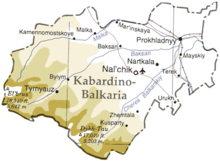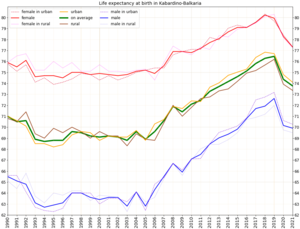Kabardino-Balkaria
Just over half (55) are located between the Baksan and Malka Rivers, the largest each of an area of no more than 0.01 square kilometers (0.0039 sq mi).
It is known that modern-day Circassians also called Kassogs were inhabiting Kabardino Balkaria since at least the 6th century BCE, then known as Zichia.
[14] On 1 July 1994 Kabardino-Balkaria became the second republic after Tatarstan to sign a power-sharing agreement with the federal government, granting it autonomy.
[16] The legislative body of the Republic is the Parliament comprising 72 deputies elected for a five-year term.
[29] According to a 2012 survey which interviewed 56,900 people,[30] 70.8% of the population of Kabardino-Balkaria adhered to Islam, 11.6% to the Russian Orthodox Church, 3.8% were non-Orthodox Christians, and 1.8% followed Adyghe (Kabardian) folk religion and other indigenous faiths.
In addition, 12% of the population declared to be "spiritual but not religious" and 5.6% was atheist or followed other religions, including Jehovah's Witnesses.










